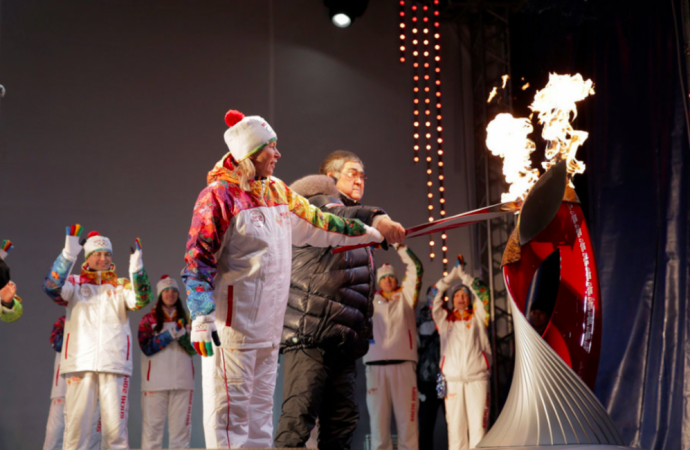With the IPCC calling for drastic societal change to prevent catastrophic global warming, Dow’s Nicoletta Piccolrovazzi explains how her organisation and the IOC are mobilising the business world and Olympic Movement
It’s both alarming and encouraging when a story about global warming is the dominant piece of news for the day. When the Intergovernmental Panel on Climate Change (IPCC) says, in no uncertain terms, that the human race has a decade to prevent climate catastrophe, it gives people the opportunity to take a deep breath, think and take the action needed to avoid the path to devastation. Alarming, yet encouraging.
According to the IPCC, all aspects of society would require “rapid, far-reaching and unprecedented changes” to limit global warming to 1.5℃. With just a half a degree jump to 2℃ (which is being projected), the global sea level will rise by 10cm by the year 2100. Coral reefs would decline by 70-90%. And the Arctic would be free of sea ice one summer per decade, compared to one summer per century if we miraculously stay within the 1.5℃ target.
The danger was illustrated starkly by David Katoatau during the Olympism in Action Forum, held over the weekend in Youth Olympic Games 2018 host city Buenos Aires. The weightlifter, who came to prominence during the Rio Olympic Games in 2016 for highlighting the plight of his native Kiribati through the medium of dance, spoke of the grave threat the island faced as a result of the change in climate.
“When I was young in Kiribati, the sea was at eight feet (from my home). Now it is much closer,” he said. “That’s why I raise my voice to the rest of the world to protect my home. I send my message to the world: save my country. I tell them to be strong and fight for this.”
It was a reminder to those present that global warming is not a problem reserved for the future. People across the world are feeling the effects now.
As one of sport’s most recognised brands, the International Olympic Committee (IOC) understands its responsibility to contribute to the 1.5℃ goal, and using its platform to encourage the Olympic Movement and fans to take responsibility for their own actions.
Over the past four years, the IOC has published its flagship Agenda 2020, in which sustainability is one of three key planks, a separate sustainability strategy, and a Sustainability Essentials guide (which will be spun out into a series) to help National Organising Committees, International Federations and other sports organisations get their own houses in order.
It has also offset 4.3 million tonnes of carbon to compensate for the emissions caused by the Sochi 2014 Winter Olympics and the Rio 2016 Summer Olympic, with sustainable development projects in Russia and Brazil reaping the benefits.

Responsible for brokering those offset investments was The Dow Chemical Company, which acted as the IOC’s Carbon Partner for both Games. That relationship has been formalised further since, with Dow becoming the Committee’s Official Carbon Partner last December.
“The work we were doing went well beyond the Games,” Dr Nicoletta Piccolrovazzi, Dow’s global technology and sustainability director of Olympic Sports Solutions, tells The Sustainability Report. “Our efforts had been very much focused on working with Local Organising Committees, but after the Games they ceased to exist. Our projects continue to be nurtured until they have delivered the CO2 reductions and climate benefits we pledged. It’s a long-term effort and the formal partnership allowed us to look long-term beyond the Games. This is a global problem and needs a consistent global platform”
In a report published last week, Dow revealed the 12 mitigation projects it had pieced together to help the IOC balance out the carbon footprint of Sochi 2014 and Rio 2016. The projects fall into three key areas: food and packaging, manufacturing and engineering, and building and infrastructure – areas where Dow has specific expertise.

For each project, Dow integrated its own technology to create sustainable solutions to lower carbon emissions in areas of particular need. In Russia, for instance, the cold climate made energy efficiency the natural area to focus on as the nation creates significant greenhouse gas emissions from burning fossil fuels to heat its residents. To counteract this, Dow worked with its Russia clients to develop an insulation in construction project so that the homeowners would not require as much energy.
One of Dow’s flagship projects in Brazil revolved around the recovery of degraded pasture land so that farmers could use it again. As well as lowering the chances of deforestation by increasing the lifespan of the land, Dow also “introduced techniques that allowed for higher productivity” so that carbon emissions were reduced significantly.
A new portfolio of similar projects is currently being developed by Dow to reflect its closer relationship with the IOC. It’s a partnership that Dow estimates will help mitigate six million tonnes of carbon emissions by 2026. But Piccolrovazzi says it’s worth more than that. From Dow’s point of view, the IOC tie-up offers the perfect platform to demonstrate the efficiency of its technology so that clients and potential clients understand and desire more sustainable solutions for their own operations.
“Very often we talk in technical terms about our technologies and solutions, but through this Carbon Partnership Programme we can help businesses understand our technologies better and give our sustainable solutions the opportunity to stand out,” she explains.
“The IOC made sustainability part of Agenda 2020 because it recognised that while it had its own operations take care of, it could mobilise the Olympic Movement and society. We have a similar way of thinking. We can provide solutions to many different sectors and we can help drive behaviour change through the Olympic Movement.”
Like the IOC, Dow has enshrined its own targets in the form of its 2025 Sustainability Goals. A major part of that ambition is the Collaborative Blueprint for Unlocking Carbon Reductions, which prioritises the forging of relationships outside Dow’s client base to “help engage the whole value chain”. The Olympic brand, of course, is an extremely engaging proposition.
One of the best examples of Dow demonstrating efficiency through sustainability is the work it’s doing for the IOC’s soon-to-be-built Olympic House – its new headquarters in Lausanne. The pair hope the building will receive LEED Platinum certifications (the highest that can be bestowed) as a result of energy-saving sealant, low-VOC (volatile organic compound) paints and a green roof being installed. Piccolrovazzi calls it a “strategic showcasing”.

“When we look at our carbon projects the thinking is that we need to help our customers and partners improve performance over incumbent market practices,” she explains. “How do we get better insulation in high-rise buildings? If we’re able to do that and catalyse many others to adopt it, we can make real change in the industry.
“It’s an approach where we are trying to help customers improve performance beyond the current business practices and using the Olympic brand to accelerate implementation.”
If Dow and the IOC can successfully accelerate the adoption of sustainable technologies and practice throughout the world of business and the Olympic movement, it could go a little way to achieving the rapid, far-reaching and unprecedented changes the IPCC is desperately calling for.










Leave a Comment
Your email address will not be published. Required fields are marked with *